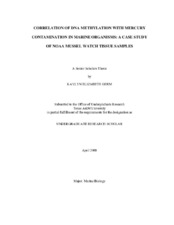| dc.creator | Brinkmeyer, Robin | |
| dc.creator | Taylor, Robert | |
| dc.creator | Germ, Kaylyn E. | |
| dc.date.accessioned | 2011-08-04T14:41:24Z | |
| dc.date.available | 2011-08-04T14:41:24Z | |
| dc.date.issued | 2011-08-04 | |
| dc.identifier.uri | https://hdl.handle.net/1969.1/98376 | |
| dc.description.abstract | American oysters (Crassostrea virginica) obtained from the NOAA Mussel Watch program were screened for DNA methylation, a type of epigenetic response to stressors. Oysters were collected from sites in the Gulf of Mexico having high mercury contamination (measured by NOAA) and from sites with little to no measurable mercury. Assessment of anthropogenic stressors such as mercury in the coastal environment has traditionally relied upon species diversity indices or assays to determine lethal doses. However, these indices fail to examine sub-lethal impacts such as gene expression. A ‘global’ DNA methylation kit, recently introduced by Sigma-Aldrich, was used to spectrophotometrically compare the degree of methylation in DNA extracted from contaminated oysters and non-contaminated oysters. DNA methylation was higher in oysters from pristine sites than in oysters from contaminated sites. | en |
| dc.format.medium | electronic | en |
| dc.language.iso | en_US | |
| dc.subject | methylation in invertebrate species | en |
| dc.subject | global methylation | en |
| dc.subject | American Oyster, Crassostrea Virginica | en |
| dc.subject | DNA methylation | en |
| dc.title | CORRELATION OF DNA METHYLATION WITH MERCURY CONTAMINATION IN MARINE ORGANISMS: A CASE STUDY OF NOAA MUSSEL WATCH TISSUE SAMPLES | en |
| dc.type | Thesis | en |
| dc.type.genre | Thesis | en |
| dc.type.material | text | en |
| dc.format.digitalOrigin | born digital | en |


